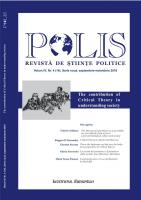The ambivalent relationship between war and peace: public speeches concerning the issue of terrorism
The ambivalent relationship between war and peace: public speeches concerning the issue of terrorism
Author(s): Anna Rita CalabròSubject(s): Security and defense, Peace and Conflict Studies
Published by: Editura Institutul European
Keywords: political speeches; ambivalence; war; peace; terrorism;
Summary/Abstract: Following the 9/11 attacks, a coalition of West Countries, led by the United States of America, militarily occupied two countries - Afghanistan and Iraq - in part rewriting the rules which up until then had clearly outlined the difference between a war of aggression and a war of defence. By analyzing the various speeches of ten important world leaders of West Democratic Countries on terrorism of fundamentalist matrix, we will outline a contradiction: declaring the necessity of war as a condition and objective of peace. This is solved in different ways: it becomes an ambivalent strategy in the cases of Obama and Merkel, with the latter being less explicit; in the cases of Bush, Berlusconi, Blair and Rice it leads, albeit with different motivations and arguments, to a stark choice: war; whereas it disappears in the speeches of Zapatero, Prodi and Cameron, who speak of actions and strategies to combat terrorism without ever mentioning war. Without offering any value judgment of the content of the various arguments, I only take them as a pretext to reflect on the rules of ambivalent communication: a communication which starts from a clear contradiction, and argues the necessity of it, before demonstrating its usefulness and proposing strategies of action that take it into account. The essay is divided into two parts: in the first one (which is published in this issue) I discuss the concept of sociological ambivalence, I distinguish ambivalence from contradictions and ambiguity and I identify the argumentative strategies of an ambivalent communication. Then I analyze the speech the President of the United States of America Barack Obama delivered on December 10, 2009 in Oslo when he received the Nobel Peace Prize as an example of “good” ambivalent communication. In the second part of the essay (which will be published in the next issue), I analyze the speeches of other world leaders as different examples of ambivalent communication.
Journal: Polis. Journal of Political Science
- Issue Year: IV/2016
- Issue No: 14
- Page Range: 195-217
- Page Count: 23
- Language: English

